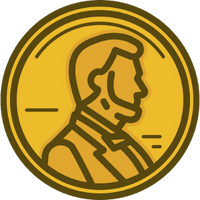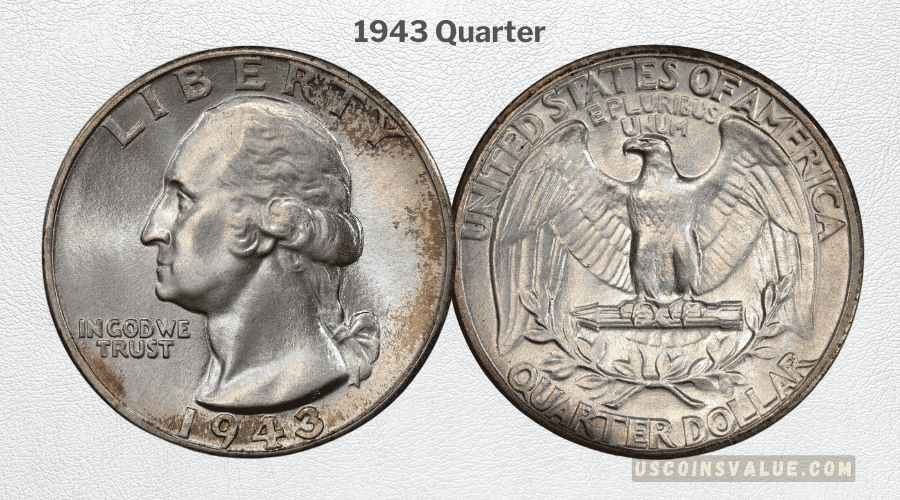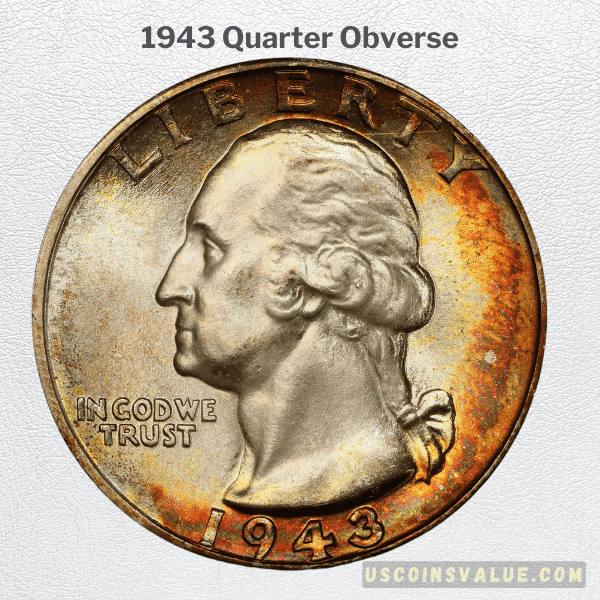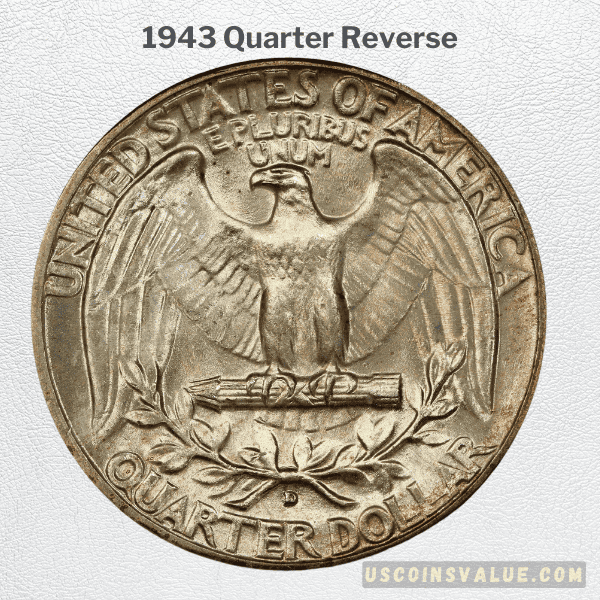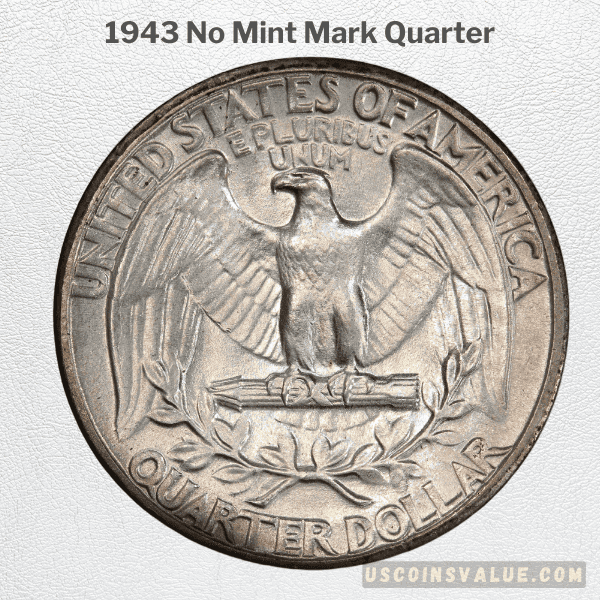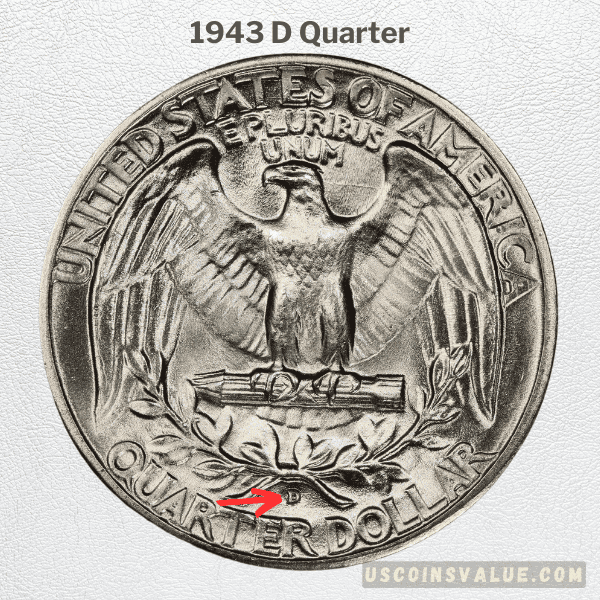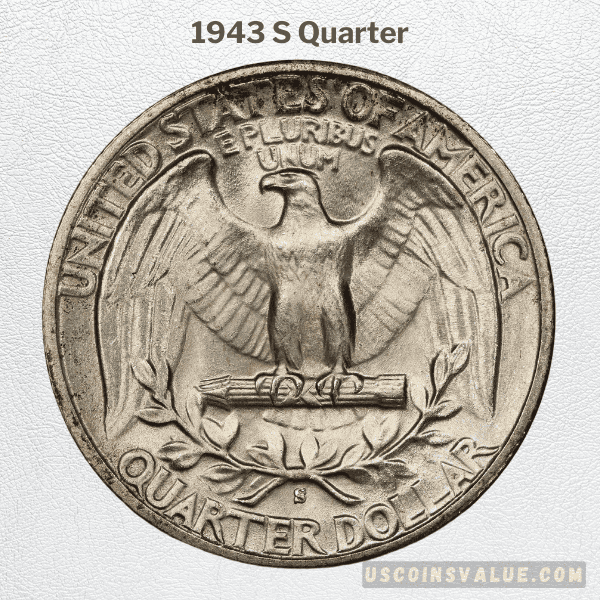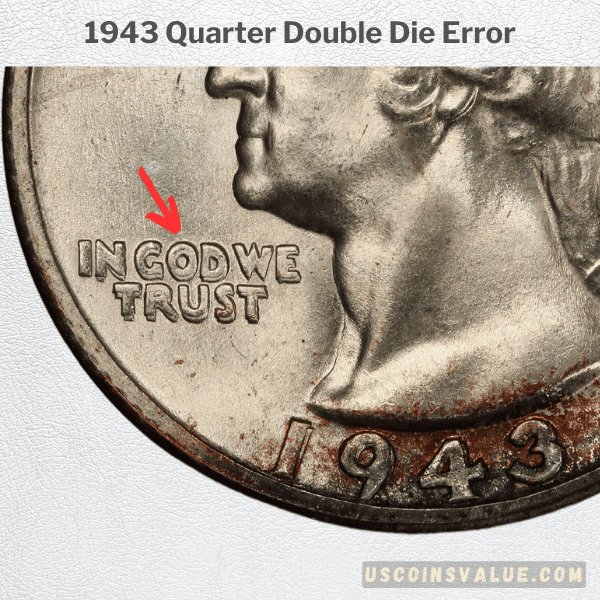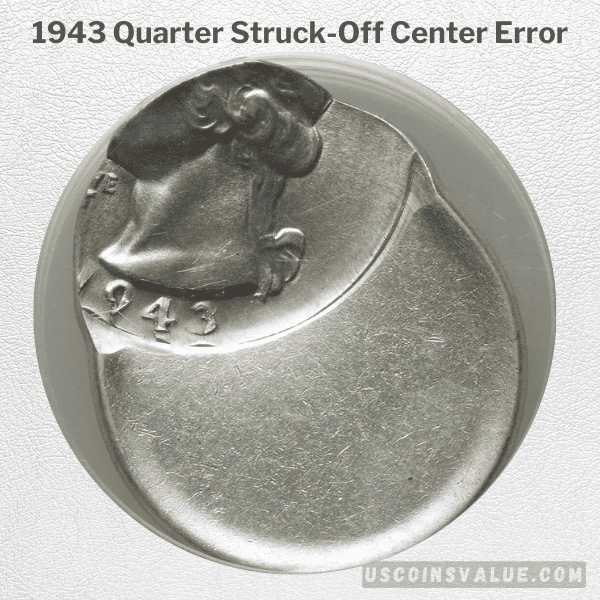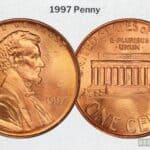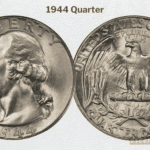How does a small, insignificant 25 cents become one of the most expensive collector items?
Believe it or not, it’s possible. That old, washed-up 1943 quarter in your coin collection could fetch as much as $840 in the open market. Of course, this applies mostly to quarters in mint state condition.
However, pieces with peculiarities, like double die obverse error, can sell for much more. For example, this 1943 quarter graded at MS 67 sold for $22,250 in 2020 at David Lawrence RC.
A similar coin, but with a lower mint state grade (around MS 64) sold for $810 in May 2023 at Heritage Auctions. While this quarter fetched a lower value than the former coin, it still demanded a premium significantly higher than its face value.
So, what makes such coins super valuable?
Well, many factors can influence their price, including condition, mint marks, varieties, and errors (major variants).
Keep on reading to learn why coin collectors are big fans of the 1943 quarter as well as the potential value of this fascinating American coin.
Is the 1943 Washington Quarter Rare?
The 1943 quarter is not super rare per se. The US Mint produced over 137 million Washington quarter that year, with Philadelphia and San Francisco mints striking 70% of the total quarters.
Although these coins were removed from circulation, some pieces survived, and you can still find them in your change. Most circulated pieces are worth their face value or value in silver, which is currently $3.67.
So, why do some individuals consider them as rare?
First off, they have a rich historical background related to the 200th bicentennial of the first president of America, George Washington.
Second, some varieties, especially in mint state or with major errors, are highly sought after by numismatics and often demand a higher premium.
Aside from that, the US government struck these quarters during World War II, which gives them sentimental value.
Is the 1943 Washington Quarter Silver?
All pre-1965 Washington quarters contain 90% silver and 10% copper, and the 1943 quarter is no different.
Although we failed to mention this earlier, the metal composition of the 1943 quarters is also another factor that influences their rarity.
That said, the US Mint shifted from silver to base metals in 1965 due to the rise in the price of silver. This meant that the intrinsic value of the coins surpassed their face value, which led to the increased hoarding of quarters and other silver coins.
However, the Washington quarters minted between 1975 and 1976 during the 200th anniversary of the independence of the United States contained some 40% silver. But they were produced especially for numismatics, not the public.
Other Features of the 1943 Quarter
Design Aspects
In 1932, New York Engraver, John Flanagan, won the competition to design the first Washington Quarter to honor the ex-president of the United States.
The quarter designed by Flanagan has a unique and modern look. It has a burst of George Washington facing right on the other side. In addition to the portrait, the front side includes some inscriptions, such as:
- LIBERTY – On top of Washington’s head
- IN GOD WE TRUST–Below his chin
- The years of minting–in this case, “1943”
On the reverse side, Flanagan settled for the heraldic American eagle holding a bundle of arrows on its talon, symbolizing the strength and power of the United States. Below the bird, you’ll find olive branches representing peace.
As for the inscriptions, the back side includes:
- UNITED STATES OF AMERICA
- LATTIN MOTTO – E PLURIBUS UNUM
- QUARTER DOLLAR
Addition 1943 Quarter Details
- Category: Washington Quarters (1932–1998)
- Mintage: 137, 495,600
- Mint Location: Philadelphia, Denver, and San Francisco
- Obverse and Reverse Design: John Flanagan
- Composition: 90% silver, 10% copper
- Weight: 6.25g
- Face Value: 25 cents
- Melt Value: $3.95
- Diameter: 24.3mm
- Edge: Reeded
Where Is the Mint Mark in the 1943 Washington Quarter?
One factor that affects the value of quarters is the mint marks. They are simply imprints that signify the location where the coin was produced.
For the 1943 Washington Quarter, the US Mint included two types of mint marks – “D” for the Denver Mint, and “S” for the San Fransisco Mint. Washington quarters from the Philadelphia Mint did not have any mint mark.
That said, let’s see how many Washington Quarters the US government struck in the three minting centers in 1943:
| Mint Mark | Mint Facility | Mintage |
| 1943 “no mint mark” Quarter | Philadelphia | 99,700,000 |
| 1943 “D” Quarter | Denver | 16,095,600 |
| 1943 “S” Quarter | San Francisco | 21,700,000 |
Unlike in 1942, the government produced fewer quarter coins in 1943, totaling around 137 million pieces.
What’s the Value of the 1943 Quarter Today?
The 1943 quarter has a face value of $0.25 or 25 cents. However, it has a high metal or melt value of around $3.67, thanks to its silver composition.
But you should not only look at the face value and melt value of the quarters to determine their price. Their condition, mint marks, and peculiarities could play a significant role, too.
In this section, we will focus more on their condition. 1943 Washington Quarters that have seen their fair share of circulation are worth anywhere between $3.67 to $7, according to NGC Coin Explorer. But if you happen to have an uncirculated sample in pristine condition, expect around $30 to $45.
In mint state condition, a quarter could end up bringing in $23,000 or more. More recently, two 1943 Washington Quarter dollars graded at MS 67 and MS67+ sold for $240 and $408, respectively. These are significantly high values considering the face value of the coin.
On that note, check out the value chart below to get an idea of the 1943 quarter selling price.
| Variety | Extremely Fine | Uncirculated | MS 60 | MS 65+ |
| 1943 “no mint mark” Quarters | $3 – $4 | $5 – $33 | $27 – $104 | $180 – $17,625 |
| 1943 “D” Quarters | $3 – $4 | $8 – $30 | $22 – $80 | $144 – $11,163 |
| 1943 “S” Quarters | $3 -$4 | $13 – $32 | $28 – $264 | $336 – $23,000 |
Now that you have a rough idea of potential 1943 quarter value, let’s look at how much each variety of this series can fetch.
1943 “No Mint Mark” Washington Quarters Value
By now, it’s clear the US Mint struck three varieties of the 1943 silver quarters. And the 1943 “no mint mark” is one of them.
Although the Philadelphia Mint recorded a slightly lower production of 1943 Washington Quarters, these coins are quite common across all grades through MS 66.
There’s also a generous population of MS 67 pieces, though some achieved this grade largely because of their outstanding toning. Such coins show no sign of wear and have an impressive luster.
Most circulated 1943 “no mint mark” coins can sell anywhere from $3.60 to $6.50 in extremely fine condition. If you have one of these quarters, you will notice signs of wear on the eagle’s breast and legs, but Washington’s hairs still look sharp.
In uncirculated condition, 1943 “no mint mark” silver quarters can sell for around $40. But those examples with strong luster, light contact marks, and a strong eye appeal can demand hundreds of dollars. For example, this 1943 25-cent graded at MS 67 sold for $408 on May 9, 2023.
| Grade | Price | Auction House | Date |
| MS 62 | $180 | Stack’s Browers | Oct, 2021 |
| MS 64 | $810 | Heritage Auctions | May, 2023 |
| MS 65 | $329 | Heritage Auctions | Jun, 2015 |
| MS 67 | $22,250 | David Lawrence | Mar, 2020 |
| MS 67 | $312 | Heritage Auctions | May, 2023 |
| MS 67+ | $840 | Heritage Auctions | Aug, 2023 |
1943 “D” Washington Quarters Value
The other variant of the 1943 silver quarters worth highlighting is the 1943 “D” coin minted at Denver.
Of course, the Denver Mint struck far fewer coins than the Philadelphia Mint. However, they are relatively easy to find, unlike the 1942D or 1941D.
There are also many Gem and super Gem survivors through MS 66 and MS 67.
In circulated condition, the selling price of these quarters starts at around $8 to $25. But those pieces that never saw circulation and still have mint luster can be worth more money, with examples selling for more than $17,000.
| Grade | Price | Auction House | Date |
| MS 64 | $172.50 | Heritage Auctions | Apr, 2008 |
| MS 65 | $100 | Stack’s Bowers | Mar, 2023 |
| MS 66 | $89 | Heritage Auctions | May, 2023 |
| MS 67 | $204 | Heritage Auctions | May, 2023 |
| MS 67+ | $1,050 | Heritage Auctions | May, 2022 |
| MS 67+ | $900 | Heritage Auctions | Dec, 2022 |
| MS 68 | $1,800 | Heritage Auctions | Dec, 2022 |
1943 “S” Washington Quarters Value
In 1943, the San Francisco Mint recorded its highest production of Washington Quarters, minting over 21 million coins.
Unlike the 1941S and 1942S quarters, the 1943S are less scarce in Gem and Superb mint state conditions. Many people saved rolls of the 1943S with the expectation they would have significant value in the future.
True to their belief, some 1943S quarters have sold for impressive prices over the years, including the following:
| Grade | Price | Auction House | Date |
| MS 64 | $480 | Heritage Auctions | Jun, 2023 |
| MS 65 | $149 | Heritage Auctions | Feb, 2023 |
| MS 66 | $216 | Heritage Auctions | Feb, 2023 |
| MS 66+ | $264 | Stack’s Bowers | Mar,2023 |
| MS 67 | $330 | Heritage Auctions | Apr, 2023 |
| MS 67 | $336 | Heritage Auctions | Jan, 2023 |
| MS 67+ | $1,560 | Heritage Auctions | Dec, 2022 |
| MS 68 | $20,400 | Heritage Auctions | Jun, 2019 |
| MS 68 | $5,760 | Heritage Auctions | Jan, 2020 |
1943 Washington Quarter Error List
It’s no surprise the 1943 Washington Quarters series includes some error coins. The large mintage that year led to poor preparation and maintenance of the working dies, making errors more likely.
Here are a few 1943 Quarter errors you might encounter:
1. Double Die Obverse Error (DDO)
The double die obverse error is arguably the most common error recorded in the 1943 silver quarter series.
This error often occurs because of a mistake in the die-making process. For example, a misalignment between the hub and the working die could lead to the creation of double design elements on the coin. The same rings true when the Mint uses damaged or worn dies to strike the coin planchet.
But are these error coins valuable?
Well, not all of them will demand a higher premium. However, pieces that maintain mint luster or have a high grade can start selling from $250 up to $5,000.
Check out these examples that got collectors breaking their banks:
- 1943S 25C Double Die Obverse graded at MS 67–Sold for $18,000 in 2021 at Heritage Auctions
- 1943S Washington Quarter, Double Die Obverse MS 66–Sold for $6,000 in Jun, 2023
- 1943S 25-cent NGC MS 66, Double Die Obverse–Sold for $1,351 at Heritage Auctions
- 1943 25-cent Double Die Obverse, MS 64 PCGS–Sold for $810 on May, 2023
2. Struck-Off Center Error
Here’s another interesting error you might encounter: the 1943 Washington Quarter Struck Off Center Error.
Quarters with this error usually have a portion of their design missing, leaving a prominent blank section on one side. This happens when the coin is not properly aligned with the coin dies during the minting process.
Coin collectors and enthusiasts find these error coins fascinating due to their unique appearance. Some are even willing to pay thousands of dollars for such a piece. In fact, a collector paid $4,200 in 2021 for a 1943 25-cent silver quarter struck 65% off-center and graded at PCGS MS 63.
Remember, the value of these error coins might vary based on the degree of the off-center, condition, and mint mark.
Besides these errors, you can check the following error coins:
1943S Washington Quarter Struck on A Five Cent Planchet MS 64–Sold for $3,818.75 in Nov 2, 2013
1943 25-cent Quarter Cracked Planchet Error–Sold for $84 at Heritage Auctions in 2021
Final Words
The 1943 Washington Quarter is by no means the rarest quarter out there, but it’s visually appealing and tells a story of America during World War II.
So, should you find a piece that sports a rare error or, in its purest form, don’t just toss it in your change jar. Get it checked out by a specialist or graded by NGC or PCGS.
You never know! Maybe you’ve scored an incredible collector’s item worth much more than its face value.
